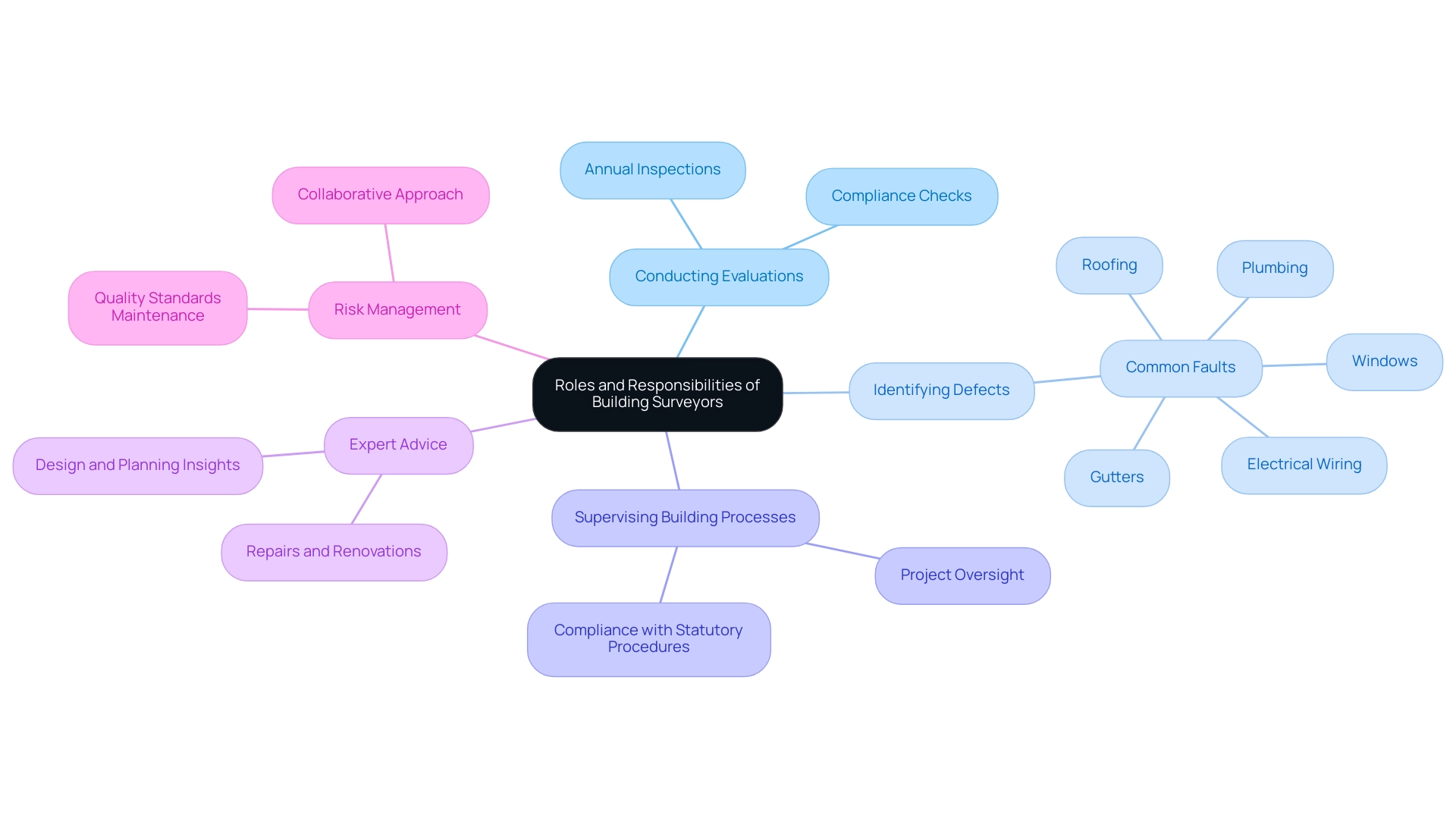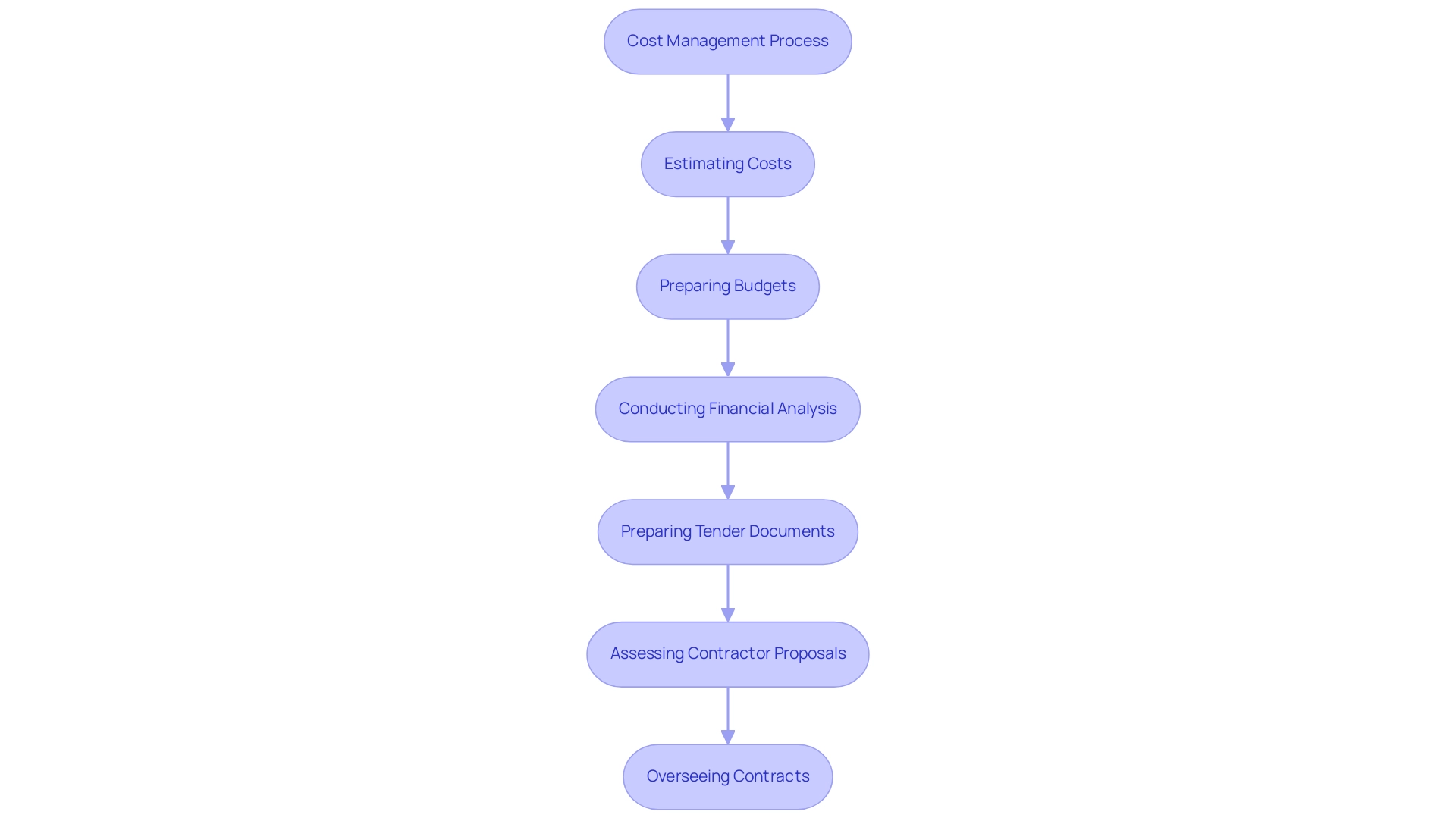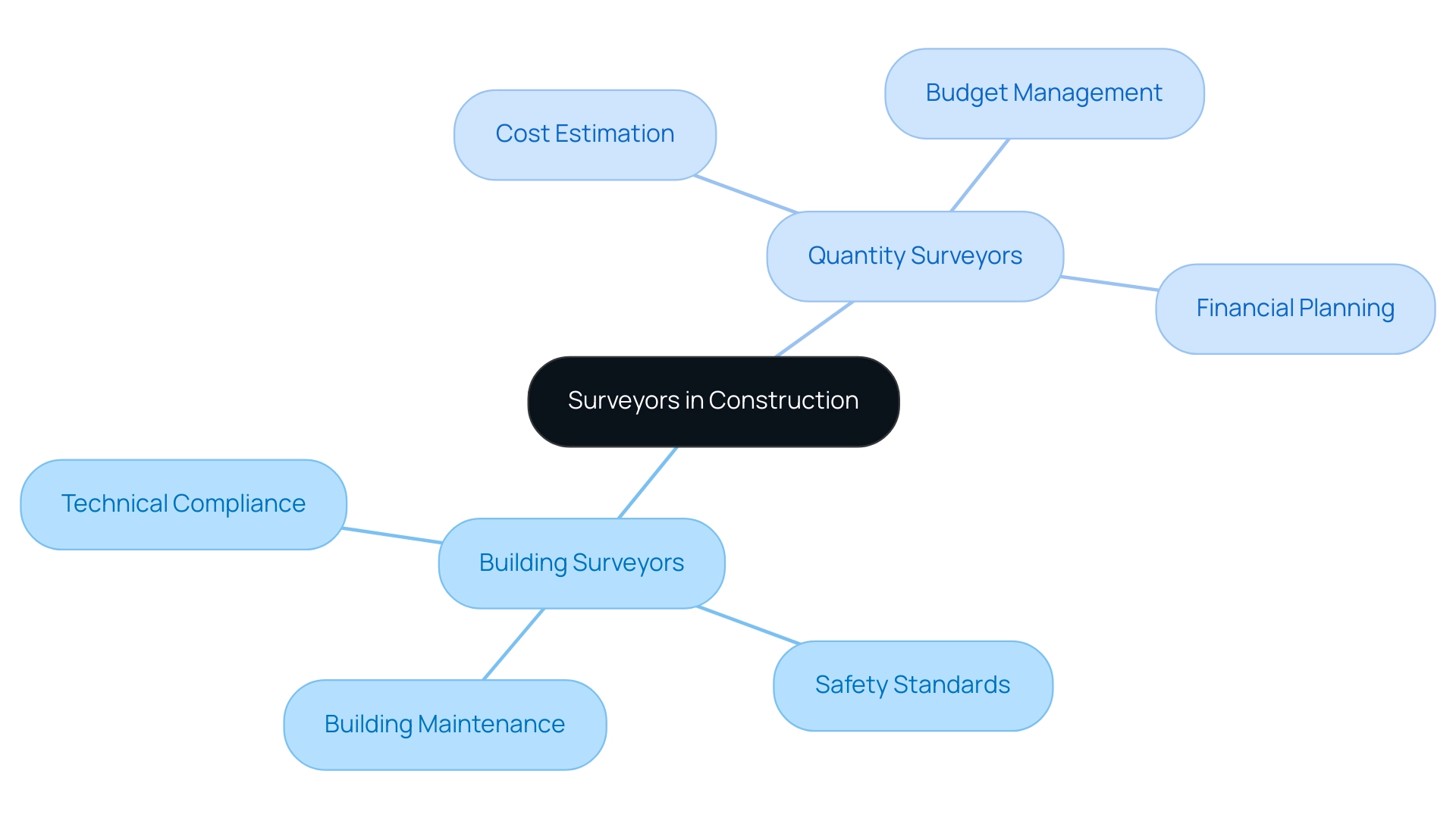
Overview
In the realm of construction, building surveyors play a crucial role in ensuring safety and compliance, while quantity surveyors are tasked with managing the financial aspects, including cost estimation and budgeting. Both roles are indispensable for the success of any project.
- Building surveyors safeguard integrity and ensure adherence to regulations.
- Quantity surveyors mitigate financial risks.
This collaboration is essential throughout the construction process, highlighting the necessity of their combined expertise to navigate the complexities of modern construction projects. Engaging both types of surveyors not only enhances project outcomes but also fosters a seamless integration of safety and financial management.
Introduction
In the intricate world of construction, two specialised professions stand at the forefront, ensuring that projects are not only built to last but also managed effectively from a financial perspective.
- Building surveyors focus on the technical integrity and compliance of structures, safeguarding safety and regulatory standards.
- Quantity surveyors navigate the complex financial landscape, steering budgets and cost management to maximise investment returns.
As the construction industry evolves, particularly in 2025, the synergy between these roles becomes increasingly vital. This collaborative approach enhances project outcomes, underscoring the importance of their partnership.
This article delves into the core functions, responsibilities, and educational pathways of building and quantity surveyors, illustrating their indispensable contributions to successful construction projects and the significance of navigating contemporary challenges together.
Understanding the Core Functions of Building and Quantity Surveyors
Building surveyors are integral to the development sector, focusing primarily on the technical aspects of structures. Their responsibilities include:
- Ensuring compliance with safety regulations
- Assessing structural integrity
- Conducting inspections of existing buildings
They provide crucial advice on repairs and renovations, which is essential for maintaining the longevity and safety of structures.
In 2025, the focus on compliance and safety standards has intensified, reflecting a broader industry trend toward prioritising structural integrity and regulatory adherence. Naismiths’ technical due diligence services enhance this role by providing comprehensive asset assessments that identify potential risks and ensure proactive maintenance management, ultimately contributing to success.
Conversely, quantity surveyors specialise in the financial oversight of building projects. Their expertise encompasses:
- Cost estimation
- Budgeting
- Financial management
This ensures that projects remain within fiscal constraints. This role is increasingly vital as the construction industry faces economic pressures, with a projected growth rate of 4 per cent for all occupations from 2023 to 2033.
Quantity specialists play a key role in mitigating financial risks and preventing cost overruns, thereby enhancing return on investment for stakeholders. Recent case studies, such as ‘Role of Quantity Surveyors in Building Initiatives,’ illustrate their critical function in ensuring financial transparency and value for money, which are essential for the successful execution of building projects.
The collaborative efforts throughout the construction process underscore the complementary nature of building surveyors and quantity surveyors. Building surveyors ensure that developments meet safety and compliance standards, while quantity surveyors manage the financial dimensions, creating a balanced management approach. This synergy is crucial for achieving optimal results, Naismiths’ customer-focused approach underscores risk management and a cooperative spirit, ensuring that all parties achieve the best possible outcomes while maintaining high-quality standards throughout each project.
Furthermore, Naismiths Analytics offers an advanced cost forecasting tool that enhances decision-making in building projects, delivering precise cost information and performance evaluations that are vital for effective risk management. As the industry evolves, the integration of these roles will remain essential in addressing the challenges of compliance, safety, and financial management.
The Role of Building Surveyors: Responsibilities and Expertise
Building Surveyors play a crucial role in the building sector, tasked with conducting thorough evaluations to ensure that structures comply with local regulations and safety criteria. Their responsibilities encompass assessing the structural integrity of buildings, identifying defects, and providing expert advice on necessary repairs or modifications. By 2025, the scope of their responsibilities has expanded to include a more significant role in management, where they supervise building processes to guarantee adherence to regulations and quality standards.
With an average of over 1,000 evaluations conducted annually by each building surveyor, their expertise is vital in upholding safety and compliance across various initiatives, this high volume of inspections underscores their significance in the building sector. Recent statistics indicate that compliance rates for building inspections have improved, reflecting an increasing emphasis on rigorous safety standards within the industry.
This trend is further underscored by a recent poll revealing that the most common faults discovered during inspections include:
- Roofing
- Electrical
- Windows
- Cladding
- Plumbing
The expertise in distinguishing ‘building surveyor vs quantity surveyor’ is crucial for recognising and addressing these issues, ensuring that endeavours meet safety standards. In the context of building surveyor vs quantity surveyor, building surveyors provide invaluable insights during the design and planning phases of developments, ensuring that proposed initiatives are both viable and secure.
Their profound understanding of building regulations enables them to advise on repairs and renovations effectively, contributing to the overall success of construction initiatives. Naismiths emphasises risk management and a cooperative ethos, ensuring that all parties achieve optimal results while maintaining high-quality standards throughout each endeavour. This customer-centric approach is mirrored in the work of building surveyors, who prioritise clients’ commercial interests while navigating sensitive situations.
Moreover, Naismiths’ comprehensive contract phase monitoring and risk management services are exemplified in their oversight capabilities. Naismiths adopts a data-first, commercially focused approach to asset management, analysing strategies and conducting cost assessments to enhance performance. As the industry evolves, the role of building professionals continues to adapt, emphasising their importance in fostering safe and compliant environments.

The Role of Quantity Surveyors: Cost Management and Financial Oversight
Quantity surveyors play a crucial role in ensuring the financial success of construction endeavours. Their main responsibilities include:
- Estimating costs
- Preparing detailed budgets
- Conducting thorough financial analysis throughout the lifecycle
This involves preparing tender documents, assessing contractor proposals, and overseeing contracts to guarantee compliance with financial agreements.
In 2025, the financial management methods of quantity surveyors have progressed considerably, with a strong focus on incorporating advanced cost estimation techniques and utilising technology for improved accuracy. Recent research shows that initiatives without the supervision of cost estimators face budget excesses of up to 20%, highlighting the essential nature of their position in preserving financial discipline.
By carefully tracking expenditures and uncovering cost-reduction opportunities, quantity surveyors not only assist clients in optimising their investments but also reduce financial risks linked to construction endeavours. Their proficiency in financial management is further illustrated by practical instances where quantity surveyors have successfully carried out financial evaluations that resulted in average savings of roughly 15% on large-scale developments.
Current trends in cost management highlight the increasing reliance on data analytics and forecasting tools, enabling construction professionals to provide more precise financial insights. This shift is crucial as engineering and building firms face challenges such as labour mismatches and evolving industrial policies. Consequently, the role of quantity surveyors is becoming more strategic, concentrating on aligning financial objectives with development goals.
Furthermore, the significance of gender diversity within the field is receiving acknowledgment, as research indicates that increasing gender representation among quantity surveyors could greatly enhance the effectiveness and value they contribute to the building industry. This aligns with wider industry trends promoting inclusive practices that encourage innovation and collaboration.
In summary, professionals, exemplified by Naismiths’ expertise, are essential in managing the complexities of construction projects, ensuring that projects are not only completed on time but also within budget, thereby protecting the financial interests of all parties involved.

Key Differences Between Building Surveyors and Quantity Surveyors
The distinction between building surveyors and quantity surveyors primarily lies in their focus areas and responsibilities within the development process. Building Surveyors, such as those at Naismiths, are dedicated to the technical and regulatory dimensions of development. Their role encompasses ensuring that structures, adhere to safety standards and comply with pertinent regulations.
Their involvement often extends to the inspection, maintenance, and evaluation of existing buildings, playing a crucial role in safeguarding public safety and enhancing building efficiency.
Conversely, quantity surveyors concentrate on the financial management of construction projects. With approximately 63,000 quantity surveyors in the UK as of Q3 2024, they oversee budgeting, cost estimation, and financial planning, ensuring projects are executed within established financial parameters. Their proficiency in cost control is essential for sustaining viability and profitability, especially in an industry increasingly constrained by financial limitations.
Recognising the unique contributions of each role is vital for clients navigating the complexities of construction projects. For instance, a recent analysis revealed that the involvement of quantity surveyors can significantly affect the success rates of initiatives, with data indicating that projects managed under their guidance are more likely to stay within budget and timeline constraints.
Moreover, industry experts emphasise the importance of collaboration between these two roles. Naismiths advocates for risk management and a cooperative approach, ensuring that all stakeholders achieve optimal results while maintaining high-quality standards throughout each project. Merging the technical expertise of building professionals with financial acumen can yield more successful outcomes.
This collaborative strategy not only enhances the quality of construction but also ensures that all parties are aligned in their objectives, ultimately leading to elevated standards of delivery. In summary, while both building surveyors and quantity surveyors are indispensable to the process, their distinct focuses technical compliance versus financial management—highlight the necessity for clients to engage the appropriate professional at various stages of a project. This understanding is particularly pertinent in 2025, as the construction landscape continues to evolve, necessitating a nuanced appreciation of these roles.
Additionally, Naismiths distinguishes itself in the market through its director-led instruction and commitment to prioritising clients’ commercial interests, further underscoring the significance of both roles in achieving project success.

Pathways to Becoming a Building or Quantity Surveyor: Education and Qualifications
To pursue a career as a building surveyor, individuals generally need to obtain a degree in building surveying, architecture, or a closely related discipline, complemented by practical work experience. Depending on the region, professional accreditation may also be a prerequisite. In contrast, aspiring quantity surveyors typically require a degree in cost estimation, project management, or surveying.
Notably, many employers favour candidates with degrees accredited by the Royal Institution of Chartered Surveyors (RICS), as this significantly enhances their employability in a competitive job market.
As of 2025, the educational landscape for these professions is evolving, with a growing emphasis on modern construction methods and effective asset management strategies. A recent study revealed that out of 315 accredited degrees offered by 157 universities, only 69 degrees from 32 universities incorporate Offsite Construction (OSC) or Modern Methods of Construction (MMC) into their curriculum. This highlights a significant gap in the training of quantity surveyors, as the incorporation of OSC knowledge is vital for their career longevity and adaptability in a rapidly evolving industry.
Both construction and quantity surveying specialists are also expected to participate in continuous professional development to stay informed about industry standards and regulations. Present credentials for quantity surveyors include a solid grounding in financial management and cost control, while building surveyors must be knowledgeable about building regulations and property law. Furthermore, the percentage of professionals in the field holding professional accreditation serves as a key indicator of industry standards, with many employers prioritising candidates who have achieved this recognition.
Real-world examples illustrate the importance of these qualifications. For instance, the integration of lean production principles and OSC techniques into quantity surveying curricula is recommended to enhance professional competencies. This approach not only prepares graduates for the evolving building landscape but also aligns with the industry’s increasing demand for advanced skills and knowledge.
Naismiths emphasises, the focus on risk management and collaboration is crucial for achieving the best outcomes in the industry. Additionally, the Impact of Offsite Construction on Quantity Surveying Education, underscores the necessity for educational programmes to adapt to technological advancements, further supporting the argument for integrating OSC knowledge into curricula.
In the context of asset management, overseeing and monitoring assets throughout the construction process lifecycle is essential. This includes analysing strategies and asset management systems to ensure effective oversight. A venture typically falls into two phases: the initial phase involves setting objectives, reviewing budgets, and considering procurement and compliance, while the second phase focuses on monitoring progress and quality through regular site visits and reporting.
As the development industry continues to adjust, the educational routes for builders and quantity surveyors will play a crucial role in shaping the future of these careers, ensuring efficient oversight and success.
Collaboration in Construction: How Building and Quantity Surveyors Work Together
Building and quantity surveyors are pivotal to the success of development projects, collaborating from the initial planning phases through to project completion. During the planning phase, the distinction between building surveyor and quantity surveyor becomes evident: building surveyors lend their expertise in compliance and safety regulations, while quantity surveyors concentrate on cost estimation and budget management strategies. This collaborative approach is essential for navigating the complexities of modern construction.
Effective communication between these two professions is critical throughout the construction process. Regular updates and discussions enable them to swiftly address emerging issues, ensuring that projects remain on track both financially and structurally. Statistics indicate that initiatives characterised by strong collaboration between construction professionals and quantity surveyors achieve a 30% greater success rate in adhering to deadlines and budget limitations compared to those with less integrated teamwork.
In 2025, the importance of cooperation between construction experts and quantity surveyors has never been more pronounced. As construction endeavours grow in complexity, the synergy between these roles directly influences project outcomes. For instance, Naismiths’ recent oversight of the projects exemplifies how a collaborative effort between builders surveyors and quantity surveyors can lead to significant reductions in delays and budget overruns, ultimately enhancing client satisfaction.
Naismiths provides a range of monitoring services, including risk management, compliance checks, and budget oversight, all of which are critical to ensuring project success. Expert insights emphasise that effective collaboration fosters a culture of transparency and accountability. This is particularly evident, where building surveyors and quantity surveyors engaged in collaborative problem-solving sessions, resulting in innovative solutions that benefit all parties involved.
Moreover, Naismiths’ expertise in transforming historic buildings is evidenced through successful case studies, demonstrating their ability to harmonise modern requirements with historical integrity. As the construction landscape continues to evolve, the partnership between a building surveyor and quantity surveyor will remain a cornerstone of successful project delivery, with tools like Building Information Modelling (BIM) further enhancing communication and coordination among project stakeholders.
Conclusion
The roles of building surveyors and quantity surveyors are indispensable in navigating the complexities of the construction industry, especially as it evolves in 2025. Building surveyors ensure compliance with safety and regulatory standards, conducting thorough inspections and providing essential advice on integrity and repairs. Their expertise is vital for maintaining the safety and longevity of buildings, while their involvement in project management enhances the overall quality of construction initiatives.
Conversely, quantity surveyors concentrate on the financial aspects of construction projects, overseeing cost estimation, budgeting, and financial management. Their capacity to identify potential cost savings and mitigate financial risks significantly influences project success rates. The collaboration between these two professions fosters a balanced approach that optimises both safety and financial performance, ensuring that projects are completed on time and within budget.
Understanding the distinct yet complementary roles of building and quantity surveyors is crucial for clients aiming to achieve successful project outcomes. The synergy between these professionals not only enhances the quality of construction but also cultivates a culture of transparency and accountability throughout the project lifecycle. As the construction landscape continues to grow in complexity, integrating their expertise will remain fundamental to addressing contemporary challenges and achieving optimal results.
In conclusion, the partnership between building surveyors and quantity surveyors is essential for navigating the intricacies of modern construction. By combining their unique strengths, these professionals play a vital role in delivering safe, compliant, and financially sound projects, ultimately contributing to the industry’s resilience and success.